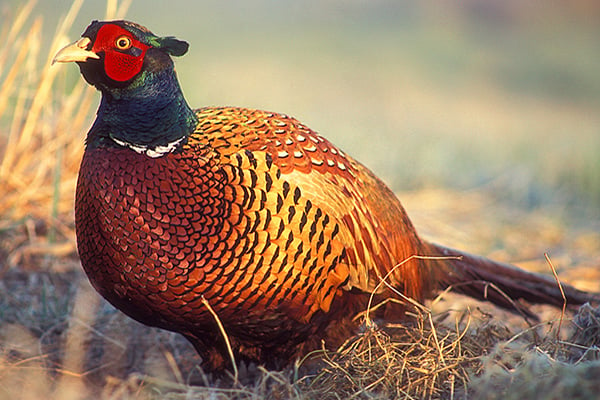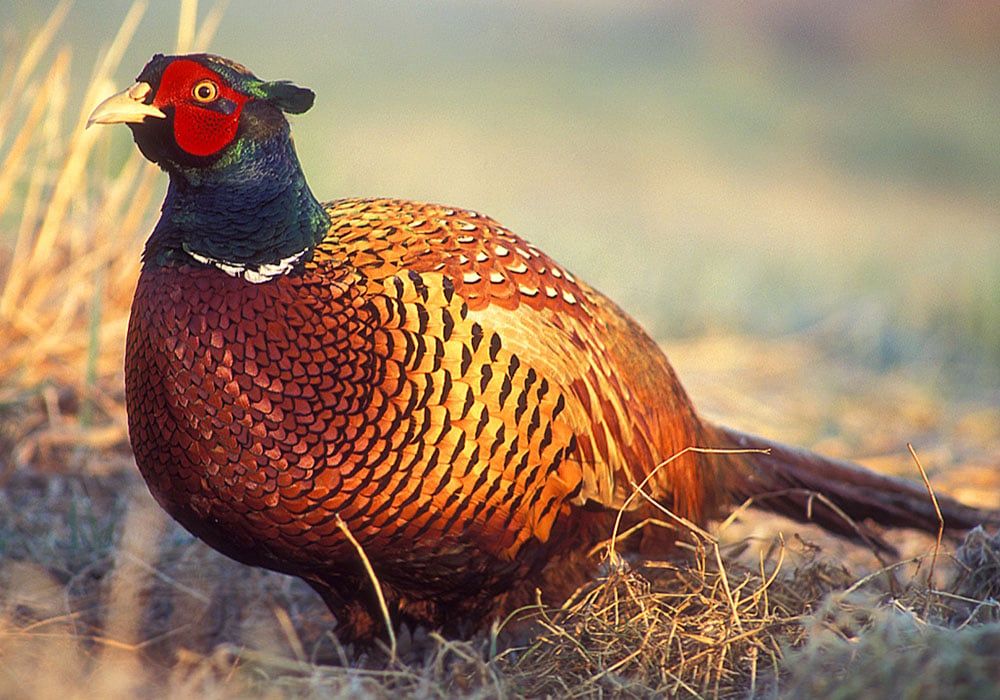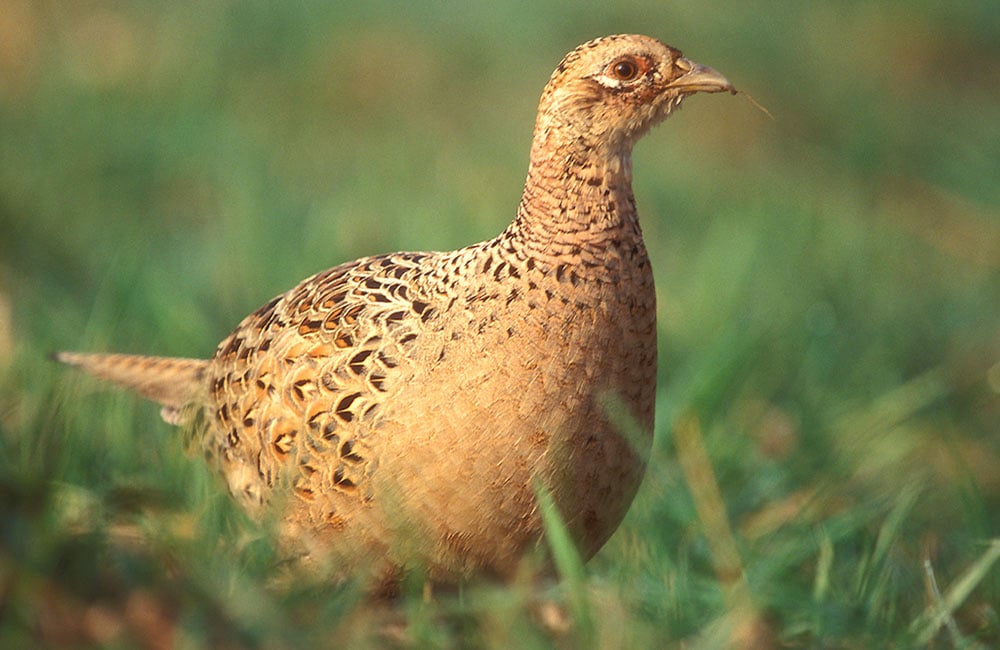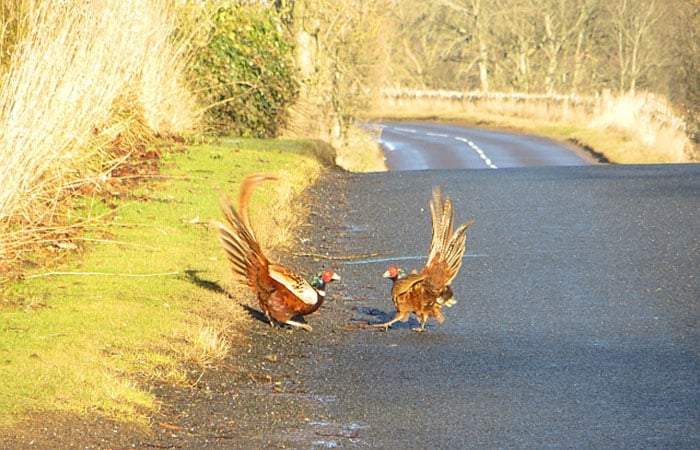
Last Updated on
When it comes to game birds, Common Pheasants are in a league of their own! Their beauty and behaviors make for an incredibly memorable hunting experience.
The Common Pheasant is, without question, one of the most beautiful and exciting game birds in North America. These birds provide unforgettable memories for hunters every year. In fact, they are one of the must hunted birds in the entire world. However, many hunters don’t even know about all the interesting characteristics and behaviors Common Pheasants’ exhibit.
Common Pheasants are also commonly referred to as Rink-necked Pheasants, Game Pheasants, True Pheasants, English Pheasants, Chinese Pheasants or just simply as Pheasants. They were introduced into the United States from Asia in the 1880s and, since then, have become North America’s favorite upland game bird.
Identification
Widely-known for the males’ striking plumage, Common Pheasant males are easily identifiable. Males, or cocks, exhibit bright red masks on each side of their faces. These masks are surrounded by iridescent green feathers throughout the head and upper neck. A distinctive white ring separates the green feathers on the upper neck from the rich chestnut and maroon plumage on the breast. Various pale-blue, golden-brown and black markings can be found across the rest of the body. Males also have a very long copper-toned tail with thin black markings.
QUICK FACT – The tail of a Common Pheasant can account for up to half its total body length!
Females, or hens, are less identifiable. They feature a shorter tail and sandy plumage without the bright colors found in males. Hens have pale brown to beige upperparts and dark brown or cinnamon underparts. Black spots can be found along the lower neck and sides.
In general, the Common Pheasant is larger and more chicken-like than most game birds (other than the Wild Turkey of course). Long legs allow them to run across the ground at surprising speeds, and their long necks allow them to see over tall grasses. Females are typically smaller than males, but both species can range in length from about 20 inches to almost 34 inches at adulthood. The average-sized Common Pheasant adult weighs approximately 2 to 3 pounds and has a wingspan of 25 to 30 inches.
Habitat and Food
Common Pheasants can be found throughout the Great Plains, the Midwest, the Rocky Mountains and the southwestern United States. They congregate on agricultural land and oil fields interspersed with brushy groves, hedges, grass ditches, woodland borders and marshes.
QUICK FACT – Common Pheasants do not have sweat glands. To get rid of excess body heat, they pant like your dog!
They often move to different habitats depending on the season. During Spring and Summer, they tend to roost in dense shrubs and trees throughout forested wetlands. They move to weedy areas and agricultural fields during the fall and seek cover along fence lines, ditches and grassy roadsides. As winter arrives, they move again to fields with abundant alfalfa and other types of hay.
Common Pheasants feed on seeds, grains, grasses, leaves, roots, nuts, wild fruits and insects throughout the year. However, they focus more on animal prey and fresh greens during the spring and summer seasons. Grasshoppers, beetles, crickets, ants, caterpillars, earthworms and snails are all on the menu.
QUICK FACT – When the weather turns bad, Common Pheasants can remain in their roost and forgo feeding for several days.
Pheasants pick up most of their food from the ground, often scratching and digging with their bills. They can reach and retrieve roots and seeds up to three inches below the top of the soil. Common Pheasants have also been known to pick waste grain from cow manure from time to time.
Behaviors
Common Pheasant males are territorial during breeding season. They establish their territories during the early spring. When intruders approach his territory, the Common Pheasant male will confront them with his head and tail up in the air. He may even tear grass and toss it in the air to show dominance.
Physical combat only occurs after a series of threat displays, but once the confrontation has escalated, the two males will fly upward breast to breast and bite each other. They often take turns jumping at each other with their bill, spurs and claws deployed. These physical altercations are rarely fatal as the one male typically runs away after a few seconds.
Females usually congregate in groups for breeding on a single male’s territory. Males court the hens with an array of different displays. In some cases, males will chase fleeing females to show them a courtship display.
Common Pheasants, like many bird species, take dust baths on a regular basis. They scratch at the ground and shake their wings to bring sand and dust into their plumage. They may also lay on their sides and rub their heads against the ground. Experts believe that this dust-bathing behavior could help remove excess oil, parasites, dead skin and old feathers.
General Common Pheasant Facts
Although Common Pheasants can usually only cover around 600 feet in one flight, they are extremely powerful in short bursts reaching almost 40 miles per hour at times. Their powerful, specialized breast muscles provide the bursting speed pheasants need to escape from trouble quickly. Strong winds can also greatly affect the total distance they can travel in the air.
Common Pheasants also have very strong leg muscles to help them scurry away to cover quickly. They may also make harsh croaking noises when they sense danger nearby.
Gear and Equipment for Common Pheasant
Many experienced pheasant hunters are true gear junkies. They believe that having the right tools and equipment makes all the difference in the fields. Although it may be a stretch to categorize them as “equipment,” the bird dog is an essential tool for any pheasant hunter. The most common dog breeds for pheasant hunting include the German shorthaired pointer, the Brittany Spaniel, the English Pointer, the English Setter and various retriever breeds.
Most hunters prefer a 12 gauge shotgun for pheasant hunting. However, a 16 or 20 gauge can work, especially for ladies and youth hunters. Choosing the right shotgun for pheasant hunting is all about your comfort. A lightweight over-under is the top choice for many experienced shooters, but most pheasant hunters start with a pump-action. Some stick with a pump-action to take advantage of the third shell capability. Other types of shotguns, like semi-autos, are often too heavy to lug around during a long walk through the fields.
Since Common Pheasants are fairly large birds, it is important to choose a load heavy enough to get the job done. Experienced pheasant hunters often use high brass shells with 4 or 5 shot. They believe that better quality shells are worth the added investment.
Many states require hunters to have at least one blaze orange article of clothing above the waist. A blaze orange cap and vest will help increase your safety throughout the hunt. You can change out the clothing you wear under the vest depending on temperature. When it comes to your pants, look for heavyweight, rugged options. Common Pheasants may lead you through all kinds of prickers, thorns and burrs, so you want to be protected.
Finding a good pair of hunting boots is as important to a pheasant hunter as almost anything else. Pheasant hunting requires a lot of walking, so they need to be comfortable and offer good insoles. While insulation is not typically as important with pheasant hunting, waterproofing is essential as pheasants often prefer marshy cover areas.
Quick Common Pheasant Hunting Tips
When trying to drive pheasants towards another hunter, you should always be walking uphill. Common Pheasants are known to retreat through cover up hill and then fly once they hit the ridge. Your hunting partner should be stationed just on the other side to get a good shot. Avoid driving pheasants downhill as they will typically fly off before they get into range.
Like most game, Common Pheasants are most active at dawn and dusk. Timing your hunts for these periods will greatly increase your chances at success. Mornings are especially good for catching birds out in light cover while feeding.
Some of the best pheasant hunting is done when that first big cold front comes through. Not only does the snow make the pheasants easier to spot, but the cold and wet weather also makes it easier for the dogs to pick up the scent. Tracking pheasant is also easier on snow-covered or muddy ground.
The Common Pheasant is America’s favorite game bird for a reason! Just make sure you know your local hunting regulations and stay safe!








Leave a Reply